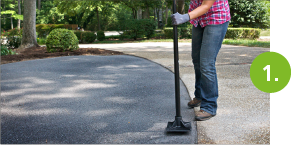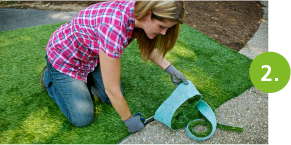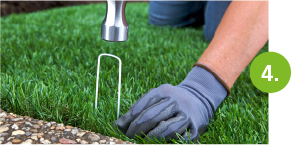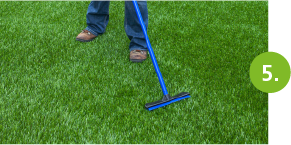How To Lay Turf: A Step By Step Guide
Step 1 - Prepare the base
Dig to a depth of 80mm in the areas where you’ll be laying your turf. Place 80mm of crushed rock/road base and compact it with a vibrating plate; this base should be between 15-20mm below the desired height of the surrounding edging/paving.
Step 2 -Trim to size
Lay the artificial grass turf where you want it and start rolling out one edge. Use a Stanley knife to cut off any over-hanging bits. Remove the black strip from both sides of the grass, as this can’t be used to join the grass.
Step 3 - Glue together seams
Place Everseal adhesive tape along the seams where the rolls of grass meet. Lay the silver backing of tape on top of the crushed rock/base and have the white side facing upwards. Set the two pieces of grass onto the tape and make sure that both edges are placed evenly in the centre of the tape. Apply pressure onto the seams after the grass has been joined to ensure strong adhesion
Step 4 - Secure in place
After the area has been covered, the perimeters of the turf must be be nailed down at 500mm intervals with landscape pegs or flat head nails.
Step 5 - Groom your grass
The final step of the synthetic grass installation process is to use a sand spreader to top dress the turf with an even distribution of dried silica sand fill to a depth of 15-20mm. You can then use a yard broom to evenly sweep the sand in and to also brush the grass blades straight.
Important
- The rolls of your artificial turf should be cut into manageable lengths before moving it. It’s also recommended that you don’t lift the turf without assistance.
- Always run grass in the same direction.
- Refer to the Product Specification Sheet for recommended amount of infill required.
All artificial turf products that Artificial Grass Shop has for sale are made to withstand the effects of the harsh Australian climate, including standard surface temperatures of approximately 65-75C. The fibres of the turf will start to shrink and eventually melt away or disintegrate if the temperature rises above melting point. This may happen if sunlight is reflected off surfaces such as doors, windows, polished gutters, mirrors, reflective panels or any other surface that may reflect sunlight onto the turf.
The best way to prevent this from happening is to not lay the turf directly up against any reflective surfaces by creating a 100cm border between them. You can also place an awning or a screen over your windows, put a coat of non-reflective paint on shiny surfaces such as drainpipes and gutters, or alter the angle of any reflective panels or mirrors.
If the reflection is being caused by something from a nearby building, you should consider using an alternative turf product for that specific area. One option is making a soiled area with a small tree or plants, pebbled rocks or a pond.
Find Out More Today
Get in touch with Artificial Grass Shop today by calling 03 9830 8646 or submitting an online enquiry to get further synthetic grass installation tips from our experts.






